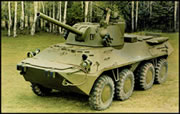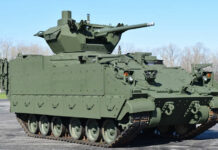
Mobile mortars and their applicationin the modern battle
Development Trends in Russian Mobile Mortars

The first serious development in mobile mortar systems came from the Soviet Union, in the immediate post WW2 era. During the war years, the Russinas showed little interest in mobile mortars, in fact, on dedicated SP artillery, the main focus being on ad-hoc anti-armour solutions against the overhelming German panzers. But painful battlefield experience placed self propelled artillery high on the Russian national priority and the results were some interesting solutions, which remain significant technological highlights even today. The traditional smooth-bore barrels mounted on recoil-absorbing baseplates and relatively uncomplicated supports have limited the size, which a mobile platform could support, without collapsing. The German Wehrmacht actually fielded the first mobile mortar, mounting an 8cm infantry mortar on a its SdKfz 250-7 which saw action in Russia in WW2.

First to enter service in the early Sixties, was the huge SM-240 (2S4Tyulpan) mechanised mortar system, mounting a breech-loaded 240mm heavy mortar, firing a power assisted loaded 130kg shell at 1-2 rpm to 12.5km range. The weapon was fired to the rear, the base plate lowered hydraulically from by special device. Another breech loaded mortar, was the Russian 2B9 82mm Vasilyek Automatic Mortar system, which represented a clear break-through in post-war mortar technology. The Vasilyek was recoil operated, munitions fed by four-round clips into the breech, achieving cyclic rate of fire 40-60 rpm in two seconds mounted on a tracked MT-LBu light armoured vehicle. Several derivatives were modified by foreign armies, one of the most interesting, an Iraqi version mounting four rear firing 120mm mortar tubes on a common rear-lowered base.
Additional Parts of this article :
- Modern Mobile Mortars
- Modern Mobile Mortars from Russia
- Origins of Russian Mobile Mortars
- Modern Mobile Mortars Trends
- Mortars in Israeli Army Use
- Advanced 120mm Mortar Munition
- Precision Munitions for 120mm Mortars – US Developments
















